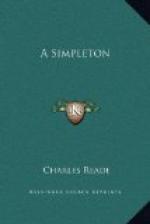The moon was now up; but so was the breeze: fleecy clouds flew with vast rapidity across her bright face, and it was by fitful though vivid glances Staines examined the raft and his companion.
The raft was large, and well made of timbers tied and nailed together, and a strong rail ran round it resting on several uprights. There were also some blocks of a very light wood screwed to the horizontal timbers, and these made it float high.
But what arrested and fascinated the man’s gaze was his dead companion, sole survivor, doubtless, of a horrible voyage, since the raft was not made for one, nor by one.
It was a skeleton, or nearly, whose clothes the seabirds had torn, and pecked every limb in all the fleshy parts; the rest of the body had dried to dark leather on the bones. The head was little more than an eyeless skull; but in the fitful moonlight, those huge hollow caverns seemed gigantic lamp-like eyes, and glared at him fiendishly, appallingly.
He sickened at the sight. He tried not to look at it; but it would be looked at, and threaten him in the moonlight, with great lack-lustre eyes.
The wind whistled, and lashed his face with spray torn off the big waves, and the water was nearly up to his knees, and the raft tossed so wildly, it was all he could do to hold on in his corner: in which struggle, still those monstrous lack-lustre eyes, like lamps of death, glared at him in the moon; all else was dark, except the fiery crests of the black mountain-billows, tumbling and raging all around.
What a night!
But, before morning, the breeze sank, the moon set, and a sombre quiet succeeded, with only that grim figure in outline dimly visible. Owing to the motion still retained by the waves, it seemed to nod and rear, and be ever preparing to rush upon him.
The sun rose glorious, on a lovely scene; the sky was a very mosaic of colors sweet and vivid, and the tranquil, rippling sea, peach-colored to the horizon, with lines of diamonds where the myriad ripples broke into smiles.
Staines was asleep, exhausted. Soon the light awoke him, and he looked up. What an incongruous picture met his eye: that heaven of color all above and around, and right before him, like a devil stuck in mid-heaven, that grinning corpse, whose fate foreshadowed his own.
But daylight is a great strengthener of the nerves; the figure no longer appalled him—a man who had long learned to look with Science’s calm eye upon the dead. When the sea became like glass, and from peach-color deepened to rose, he walked along the raft, and inspected the dead man. He found it was a man of color, but not a black. The body was not kept in its place, as he had supposed, merely by being jammed into the angle caused by the rail; it was also lashed to the corner upright by a long, stout belt. Staines concluded this had kept the body there, and its companions had been swept away.




